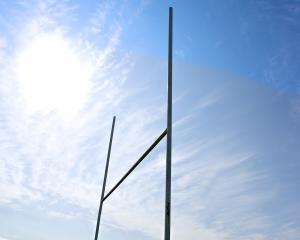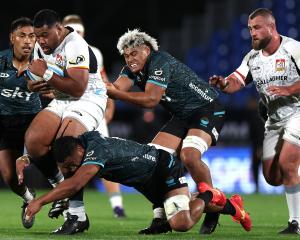It's the bad smell that won't go away. The sham tactic that has become rugby's great leveller. But no matter that All Blacks coach Steve Hansen is right when he says rolling mauls are "bloody boring"; that they are the scourge of today's game - afforded their own ridiculous, unfathomably contrary laws - they are going to be the foundation stone of the World Cup.
Whatever anyone says now about using it sparingly, the reality in October will be different.
Come the final 20 minutes of each knockout game, there will be one thought and one thought only running through the minds of most teams - force a penalty, hoof the ball into the corner and set up the rolling maul. Under pressure - it will be the move of choice for South Africa, England, Ireland, Wales, France, Argentina and Australia.
The All Blacks will get their first taste of this at Ellis Park overnight. There will be an element of phoney war about the clash - neither team is going to give everything away - but the All Blacks are going to be asked to defend a significant number of rolling mauls.
"If we are under any illusions about what South Africa are going to do, we know they will scrum for penalties, they will kick for lineouts and they will drive," said Hansen after his side's 38-19 victory against Argentina. It was a comment sparked by the two soft tries the All Blacks conceded to the Pumas driving maul.
"I think it is the hardest part of the game to fix," lamented Hansen. "One of the things we didn't do tonight was break it down early enough. We just didn't get in on their wedges quick enough and as soon as they took it off centre we were in trouble. They were soft tries."
And they were tries that have set a nation's nerves jangling. No country does angst quite like New Zealand in World Cup year. The perception has firmed that the All Blacks are neither good exponents nor good defenders of the driving maul. There's concern the All Blacks are vulnerable - that for all their explosive power, pass and catch excellence and intuitive genius, they could be done over by boofhead football teams whose only offering is a No 10 with a howitzer boot and a pack full of slow-advancing muscle.
Perception is not quite right in regards to the All Blacks' ability to use the rolling maul. They scored a few tries from lineout drives last year and the Crusaders - full of All Blacks - were capable, probably more than, of forming a useful phalanx in the final rounds of Super Rugby this year.
But it's not a tactic that is top of the agenda for the All Blacks. They predominantly look to take lineout ball off the top and shift it quickly. Their natural instinct is to use the width of the field, isolate defenders and create one-on-one encounters. And because the rolling maul is not often used as an attacking weapon, it follows that the All Blacks are not naturally good at defending it.
It doesn't appear to be an area the players read well or have well-honed instincts and as a consequence, they have struggled to be consistently good at defending it.
That's been a niggle for the last few years, but is now a serious concern because mauling has moved from an occasional to almost default attacking choice for several teams. The South Africans have, for the last decade at least, been better exponents of the rolling maul and developed considerable expertise. The bulk of their Super Rugby teams appeared almost obsessed with the tactic during Super Rugby as did the Brumbies. England were ominously good at it last year at Twickenham and the French can no longer excite or enthral, but they do know how to put seven big men in front of the ball carrier and waddle to the tryline.
Some teams are finding defences too hard to break through more creative means so up the jumper rugby is a handy means to fix that.
"It's obviously very hard to defend once they get their maul set," says All Black lock Luke Romano who is going to have a big role to play in leading the All Blacks defensive approach to rolling mauls.
"There is no real way to stop it other than out muscling them. We had the right intent [against the Pumas] but we didn't execute what we had planned to do. You really need to stop it at source - so either compete or drop it as soon as it [the catcher] comes down."
There is also a wildcard element when it comes to the rolling maul - and that's refereeing interpretation. The laws are typically loose and it became clear during Super Rugby that interpretations of what's legal and what's not differed greatly.
New Zealand Rugby Union high performance referees manager Rod Hill says the rolling maul started to become a particular area of focus during last year's Junior World Championship when defending teams implemented the tactic of stepping away from the lineout. The defending team has to engage the opposition for a maul to be formed - if they don't and the attacking team bind to the catcher and transfer the ball to the back of the group, they are obstructing because no maul has been formed.
But World Rugby doesn't like the non-competing stance - says it's contrary to the ethos of the game and referees have been told to penalise teams that step away.
The other murky development has been the use of backs in the maul and the problem here is they mostly join ahead of the ball carrier.
"All the referees going to the World Cup had a meeting in France three weeks ago," says Hill. "It was a chance for Joel Jutge [World Rugby high performance referee manager] to provide clarity on various parts of the game and relay those messages to coaches ahead of the World Cup."
The key areas referees have been told to focus on are the legality of attacking players joining the maul; the legality of the attacking team transferring the ball to the back of the maul - that process can't start until at least one opposition defender has engaged the catcher; and the old chestnut of defending players 'swimming' round the sides to get to the back of the opposition maul.
No matter that referees have been given guidance and teams clear instruction about what they can and can't do, in the heat of the battle, it is almost impossible for a referee to be sure what is happening.
It will forever be a grey area and because of that, teams who like to maul will do it to excess at the World Cup, taking a calculated risk that referees - random and inconsistent - will, however, mostly rule in the attacking team's favour.
"I think we saw in Super Rugby teams have put a lot of work into making it a real weapon," says All Black captain Richie McCaw. "We need to do some work when they [opponents] have got five metre lineouts.
"It's [rolling maul] part of the game that when the big boys up front get a chance at it, we rub our hands together. We have got make sure we have a way of stopping it as well and there is no doubt that as we go on this year there's going to be a fair bit of it."
IDIOT'S GUIDE TO ROLLING MAULS
How To Stop a Rolling Maul Legally
1: Compete for and win the ball at the lineout.
2: Tackle [what players call sack] the opposition catcher as soon as his feet hit the ground.
3: Out muscle/out power the opposition once they have the maul set up. That is - be able to exert a greater defensive force than they can to prevent them building any momentum.
What Can't the Defending Team Do?
1: It's not legal to pull the maul down once it is formed. If the referee shouts maul - effectively formed when one player from each team is bound to the ball carrier - it can't then be deliberately collapsed.
2: Players can't 'swim' though the maul. They can advance through the middle of the maul legally - but they have to be bound to other players. The term 'swimming' is used to clarify they haven't been bound.
3: Attack the opposition catcher in the air.
4: Step away from the lineout -- effectively pretend it's not happening to then create a scenario where no maul forms and the attacking side is penalised for obstruction.
What Can't the Attacking Team do?
1: Transfer the ball to the back of the maul before the opposition have engaged the catcher.
2: Send extra men into the maul ahead of the ball carrier. They have to bind either to or alongside the ball carrier.
FAQs
Why can't the defending team pull the maul down?
It has been deemed dangerous yet there is not one instance of anyone being reported injured as a result of a collapsed maul.
What happens if the maul splinters as it did in the Pumas test?
If the referee deems the splinter was the result of genuine defensive pressure, he is encouraged to wave play on. If he believes the attacking team manufactured the split, they should be penalised for obstruction or accidental offside.
- By Gregor Paul of the Herald on Sunday












